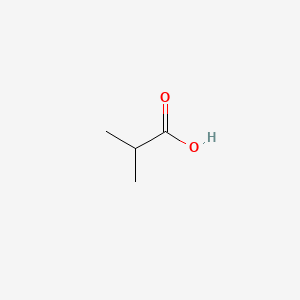| MeSH term | MeSH ID | Detail |
|---|---|---|
| Stomach Ulcer | D013276 | 75 associated lipids |
| Adenocarcinoma | D000230 | 166 associated lipids |
| Colonic Neoplasms | D003110 | 161 associated lipids |
| Body Weight | D001835 | 333 associated lipids |
| Carcinoma, Hepatocellular | D006528 | 140 associated lipids |
| Hyperlipidemias | D006949 | 73 associated lipids |
| Malabsorption Syndromes | D008286 | 16 associated lipids |
| Gastrointestinal Hemorrhage | D006471 | 27 associated lipids |
| Werner Syndrome | D014898 | 4 associated lipids |
| Myoclonic Epilepsies, Progressive | D020191 | 3 associated lipids |
ISOBUTYRIC ACID
ISOBUTYRIC ACID is a lipid of Fatty Acyls (FA) class. Isobutyric acid is associated with abnormalities such as Atrophy, Muscular, Spinobulbar. The involved functions are known as Signal Transduction, Oxidation, Vmax, Metabolic Inhibition and Regulation. Isobutyric acid often locates in Cytoplasm, Plasma membrane, peroxisome, Mouse Embryonic Fibroblast and Protoplasm. The associated genes with ISOBUTYRIC ACID are Candidate Disease Gene, CDKN1A gene, MYC gene, E2F1 gene and HBP1 gene. The related lipids are butyrate, Butyrates, lipid structure, Fatty Acids and Propionate. The related experimental models are Knock-out.
Cross Reference
Introduction
To understand associated biological information of ISOBUTYRIC ACID, we collected biological information of abnormalities, associated pathways, cellular/molecular locations, biological functions, related genes/proteins, lipids and common seen animal/experimental models with organized paragraphs from literatures.
What diseases are associated with ISOBUTYRIC ACID?
ISOBUTYRIC ACID is suspected in Atrophy, Muscular, Spinobulbar and other diseases in descending order of the highest number of associated sentences.
Related references are mostly published in these journals:
| Disease | Cross reference | Weighted score | Related literature |
|---|
Possible diseases from mapped MeSH terms on references
We collected disease MeSH terms mapped to the references associated with ISOBUTYRIC ACID
PubChem Associated disorders and diseases
What pathways are associated with ISOBUTYRIC ACID
There are no associated biomedical information in the current reference collection.
PubChem Biomolecular Interactions and Pathways
Link to PubChem Biomolecular Interactions and PathwaysWhat cellular locations are associated with ISOBUTYRIC ACID?
Visualization in cellular structure
Associated locations are in red color. Not associated locations are in black.
Related references are published most in these journals:
| Location | Cross reference | Weighted score | Related literatures |
|---|
What functions are associated with ISOBUTYRIC ACID?
Related references are published most in these journals:
| Function | Cross reference | Weighted score | Related literatures |
|---|
What lipids are associated with ISOBUTYRIC ACID?
Related references are published most in these journals:
| Lipid concept | Cross reference | Weighted score | Related literatures |
|---|
What genes are associated with ISOBUTYRIC ACID?
Related references are published most in these journals:
| Gene | Cross reference | Weighted score | Related literatures |
|---|
What common seen animal models are associated with ISOBUTYRIC ACID?
Knock-out
Knock-out are used in the study 'G1/S arrest induced by histone deacetylase inhibitor sodium butyrate in E1A + Ras-transformed cells is mediated through down-regulation of E2F activity and stabilization of beta-catenin.' (Abramova MV et al., 2006).
Related references are published most in these journals:
| Model | Cross reference | Weighted score | Related literatures |
|---|
NCBI Entrez Crosslinks
All references with ISOBUTYRIC ACID
Download all related citations| Authors | Title | Published | Journal | PubMed Link |
|---|---|---|---|---|
| Djao OD et al. | Complete genome sequence of Syntrophothermus lipocalidus type strain (TGB-C1). | 2010 | Stand Genomic Sci | pmid:21304731 |
| Vyalikh A et al. | Evidence of microphase separation in controlled pore glasses. | 2005 | Solid State Nucl Magn Reson | pmid:16061359 |
| Caroprese A et al. | HS-SPME-GC-MS analysis of body odor to test the efficacy of foot deodorant formulations. | 2009 | Skin Res Technol | pmid:19832965 |
| Parker DB et al. | Recovery of agricultural odors and odorous compounds from polyvinyl fluoride film bags. | 2010 | Sensors (Basel) | pmid:22163671 |
| Kulshreshtha NM et al. | Usefulness of organic acid produced by Exiguobacterium sp. 12/1 on neutralization of alkaline wastewater. | 2012 | ScientificWorldJournal | pmid:22666107 |
| Hubert HB et al. | Olfactory sensitivity in humans: genetic versus environmental control. | 1980 | Science | pmid:7189296 |
| Xiong M et al. | A bio-catalytic approach to aliphatic ketones. | 2012 | Sci Rep | pmid:22416247 |
| Mendes V et al. | Mycobacterium tuberculosis Rv2419c, the missing glucosyl-3-phosphoglycerate phosphatase for the second step in methylglucose lipopolysaccharide biosynthesis. | 2011 | Sci Rep | pmid:22355692 |
| Tjellström B et al. | Gut microflora associated characteristics in first-degree relatives of children with celiac disease. | 2007 | Scand. J. Gastroenterol. | pmid:17852880 |
| Jakobsdottir G et al. | Fasting serum concentration of short-chain fatty acids in subjects with microscopic colitis and celiac disease: no difference compared with controls, but between genders. | 2013 | Scand. J. Gastroenterol. | pmid:23600961 |
